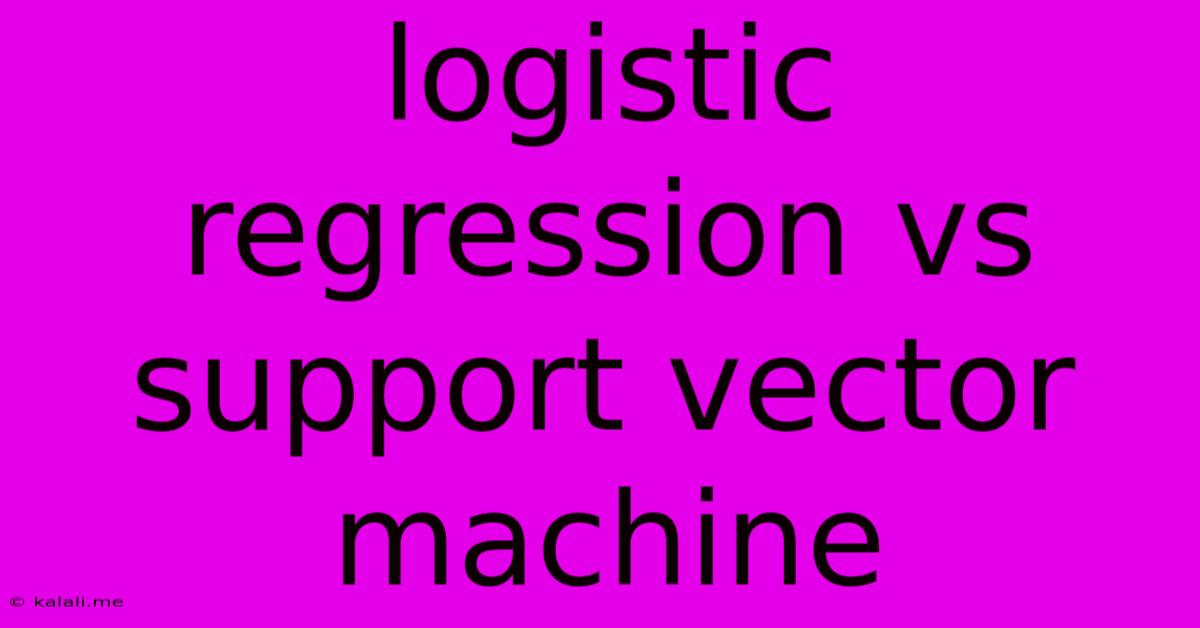Logistic Regression Vs Support Vector Machine
Kalali
May 30, 2025 · 3 min read

Table of Contents
Logistic Regression vs. Support Vector Machine: Choosing the Right Classifier
Choosing the right classification algorithm for your machine learning project can feel overwhelming. Two popular and powerful choices are Logistic Regression and Support Vector Machines (SVMs). Both are capable of achieving high accuracy, but they differ significantly in their underlying approaches and strengths. This article will delve into the key differences between logistic regression and SVMs, helping you understand which algorithm best suits your specific needs.
Meta Description: Learn the key differences between Logistic Regression and Support Vector Machines (SVMs) for classification tasks. Discover their strengths, weaknesses, and when to use each algorithm for optimal machine learning performance.
Understanding Logistic Regression
Logistic regression, despite its name, is a classification algorithm. It models the probability of a data point belonging to a particular class using a sigmoid function. The output is a probability score between 0 and 1, which is then classified based on a predefined threshold (typically 0.5). It's a linear model, meaning it creates a decision boundary that is a straight line (in 2D) or a hyperplane (in higher dimensions).
Strengths of Logistic Regression:
- Simplicity and Interpretability: It's relatively easy to understand and interpret the model's coefficients, providing insights into the importance of different features.
- Efficiency: It's computationally inexpensive and fast to train, even with large datasets.
- Probability Estimates: Provides probability estimates for each class, which can be useful in various applications.
Weaknesses of Logistic Regression:
- Linearity Assumption: It struggles with non-linearly separable data. Transformations or feature engineering might be required to handle complex relationships.
- Sensitivity to Outliers: Outliers can significantly impact the model's performance.
- Limited Feature Interactions: It doesn't inherently handle complex feature interactions well.
Understanding Support Vector Machines (SVMs)
SVMs aim to find the optimal hyperplane that maximizes the margin between different classes. The margin is the distance between the hyperplane and the closest data points (support vectors). SVMs can handle non-linearly separable data using kernel functions, which map the data into a higher-dimensional space where it becomes linearly separable.
Strengths of SVMs:
- Handles Non-linearity: Effectively handles non-linearly separable data using kernel functions (e.g., RBF, polynomial).
- Robust to Outliers: The focus on the margin makes it less sensitive to outliers compared to logistic regression.
- High Accuracy: Often achieves high accuracy, particularly with high-dimensional data.
Weaknesses of SVMs:
- Computational Cost: Training SVMs can be computationally expensive, especially with large datasets.
- Parameter Tuning: Requires careful tuning of hyperparameters (e.g., kernel type, regularization parameter), which can be time-consuming.
- Interpretability: The resulting model is less interpretable than logistic regression. Understanding the contribution of individual features can be challenging.
Logistic Regression vs. SVM: A Comparison Table
| Feature | Logistic Regression | Support Vector Machine |
|---|---|---|
| Model Type | Linear | Linear or Non-linear (with kernels) |
| Data Type | Primarily for linearly separable data | Can handle linearly and non-linearly separable data |
| Computational Cost | Low | High (can be very high for large datasets) |
| Interpretability | High | Low |
| Outlier Sensitivity | High | Low |
| Probability Estimates | Provides probability estimates | Does not directly provide probability estimates (requires calibration) |
When to Use Which Algorithm
-
Use Logistic Regression when:
- You need a simple, interpretable model.
- Your data is linearly separable or can be easily transformed to be so.
- Computational speed is a priority.
- You need probability estimates.
-
Use SVM when:
- Your data is non-linearly separable.
- Accuracy is the top priority, even at the cost of interpretability.
- You have a relatively smaller dataset.
- You are comfortable with hyperparameter tuning.
Ultimately, the best choice depends on the specific characteristics of your data and the goals of your project. Experimentation and evaluation using appropriate metrics (accuracy, precision, recall, F1-score, AUC) are crucial for determining the most suitable algorithm. Consider exploring both algorithms and comparing their performance to make an informed decision.
Latest Posts
Latest Posts
-
How Do I Turn Off Itunes
May 31, 2025
-
How Do I Cancel Myspace Account
May 31, 2025
-
Check If Service Is Running Linux
May 31, 2025
-
Socrates Dar A Luz A Ideas
May 31, 2025
-
Ceiling Fan Pull Chain Switch Replacement
May 31, 2025
Related Post
Thank you for visiting our website which covers about Logistic Regression Vs Support Vector Machine . We hope the information provided has been useful to you. Feel free to contact us if you have any questions or need further assistance. See you next time and don't miss to bookmark.